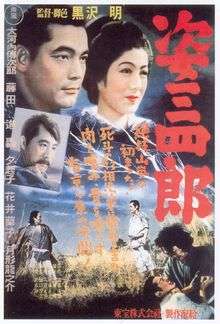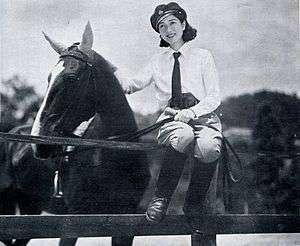Sanshiro Sugata
Sanshiro Sugata (Japanese: 姿三四郎, Hepburn: Sugata Sanshirō, aka Judo Saga) is a 1943 Japanese action drama film and the directorial debut of the Japanese film director Akira Kurosawa. First released in Japan on 25 March 1943 by Toho film studios, the film was eventually released in the United States on 28 April 1974. The film is based on the novel of the same name written by Tsuneo Tomita, the son of prominent judoka Tsunejirō Tomita. It follows the story of Sanshiro, a talented though willful youth, who travels to the city in order to learn Jujutsu. However, upon his arrival he discovers a new form of self-defence: Judo. The main character is based on Saigō Shirō.[1]
| Sanshiro Sugata | |
|---|---|
 | |
| Directed by | Akira Kurosawa |
| Produced by | Keiji Matsuzaki |
| Screenplay by | Akira Kurosawa Tsuneo Tomita |
| Based on | Sanshiro Sugata by Tsuneo Tomita |
| Starring | Denjirō Ōkōchi Susumu Fujita Yukiko Todoroki Takashi Shimura |
| Music by | Seiichi Suzuki |
| Cinematography | Akira Mimura |
| Edited by | Toshio Gotō Akira Kurosawa |
Production company | |
| Distributed by | Toho Company Ltd. |
Release date |
|
Running time | 79 / 97 minutes |
| Country | Japan |
| Language | Japanese |
The film is seen as an early example of Kurosawa's immediate grasp of the film-making process, and includes many of his directorial trademarks, such as the use of wipes, weather patterns as reflections of character moods, and abruptly changing camera speeds. The film itself was quite influential at the time, and has been remade on no fewer than five occasions. It spawned a sequel, Sanshiro Sugata Part II, which was released in 1945 and also directed by Kurosawa.
Plot
In 1883, Sanshiro is a talented though willful youth who wishes to become a jujutsu master by becoming a student at one of the city's martial arts schools. His first attempts to find a suitable instructor fail, until he finally finds an accomplished master, Shogoro Yano from the Shudokan Judo school. Initially, Sanshiro is physically capable though he lacks any type of poise or reflection concerning his self-control and demeanor, and gets involved with brawls. However, after a grueling punishment set by his instructor to test his endurance by leaving him on a cold swamp overnight, Sanshiro begins to recognize the error in his ways and starts to appreciate that there is more to his life and to his art than simple muscle and brawn. Sanshiro becomes a leading student in his school.
The city is looking to employ one of the local martial arts schools to guide the training of its local police force, and the school of Sanshiro becomes a leading candidate along with its rival, the local school of Ryōi Shintō-ryū jujutsu led by Hansuke Murai. In a scheduled competition between the two schools, Sanshiro is chosen to represent his school in a public match against Murai himself to determine which school is best to train the local police in the martial arts. The scheduled bout gets off to a slow start, but Sanshiro soon comes into his own and begins executing devastating throws which cause internal physical damage to his opponent. Although Murai tries to stand every time, energized by the memory of his daughter Sayo, he is forced to give up after the third time he is violently sent to the ground by Sanshiro.
After the match, Sanshiro makes friends with his defeated opponent and becomes attracted Sayo. Sayo is greeted as a local beauty in town and another Ryōi Shintō-ryū jujutsu master, Higaki, becomes a rival to Sanshiro for her affections. When he challenges Sanshiro to a duel to the death, Sanshiro accepts and defeats him by inflicting permanent crippling damage to Higaki. After emerging victorious from his duel, Sanshiro prepares for his next assignment in Yokohama while being escorted on the local train by Sayo. He promises to return to her after he finishes his journey.
Cast

- Susumu Fujita as Sanshiro Sugata
- Denjirō Ōkōchi as Shōgorō Yano
- Yukiko Todoroki as Sayo Murai
- Ryūnosuke Tsukigata as Gennosuke Higaki
- Takashi Shimura as Hansuke Murai
- Ranko Hanai as Osumi Kodana
- Sugisaku Aoyama as Tsunetami Iimura
- Ichiro Sugai as Police Chief Michitsune Mishima
- Yoshio Kosugi as Master Saburō Kodama
- Kokuten Kōdō as Buddhist Priest
- Michisaburō Segawa as Wada
- Akitake Kōno as Yoshima Dan
- Shōji Kiyokawa as Yūjirō Toda
- Kunio Mita as Kōhei Tsuzaki
- Akira Nakamura as Toranosuki Niiseki
- Eisaburō Sakauchi as Nemeto
- Hajime Hikari as Torakichi
Production
Following five years of second unit director work on films such as Uma and Roppa's Honeymoon, Kurosawa was finally given the go-ahead to direct his first film, even though he himself claimed that, in films like Uma, "I had been so much in charge of production I had felt like the director". After hearing of a new novel from the writer Tomita Tsuneo, Kurosawa decided the project was for him and asked film producer Iwao Mori to buy the rights for him.
According to Japanese cinema scholar Donald Richie, the reason Kurosawa was allowed to direct the film was because he had had two film scripts printed, including one of which had won the education minister's prize. However, his work was too far away from the government requirements for a wartime film. Tomita's novel, on the other hand, was considered "safe", dealing, as it did, with a Japanese subject such as the martial rivalry between judo and jujitsu, was a period piece, and was a popularist subject. Kurosawa deliberately went out to make a "movie-like movie", as he knew he would not be able to insert any particularly didactic qualities in the film.
After the initial release, Japanese censors trimmed the film by 17 minutes. This footage was never recovered; however, the original script with the missing material still exists. The 1952 re-release (from which the 2009 Criterion DVD is made) opens with (translated from the original Japanese text):
"This film has been modified from the original version of Akira Kurosawa's debut film, which opened in 1943, without consulting the director or the production staff. 1,845 feet of footage was cut in 1944 to comply with the government's wartime entertainment policies."
Paul Anderer emphasized Kurosawa's attention to the character of Gennosuke Higaki in the film. Higaki, who was created by Tsuneo Tomita for the novel taking inspiration from real life jujutsu master Mataemon Tanabe, is made in the film its central villain. Anderer stated:
"Kurosawa would later call Higaki his Mephistopheles and insist that he is the most interesting character in this film. Given the heightened drama of every scene he invades, the visual association between him and the shadow, as well as the sound of his voice -- cued as it is to the raging wind -- Higaki does spur Kurosawa to deviate from the path of a conventional wartime 'spiritist' film. The director's focus shifts away; from a wholesome story of a guileless youth, perfecting his skill along with his pure Japanese heart. He stays strangely fixed on Higaki and conveys an unmistakable sympathy for the devil, no matter the moral consequence."[2]
Themes
The central theme of the film is the education and initiation of Sugata and the way in which, whilst learning the ways of Judo, he also learns about himself. The film's central scene concerning this theme is when, after being accosted by Yano for getting involved in a streetfight, Sugata leaps into the cold waters near Yano's temple and stays there in order to show his master his dedication, and the fact that he is neither afraid to live nor to die.
Reception
Although received well enough in wartime Japan to warrant a sequel, the film received a conventional review from Dennis Schwartz writing for "Ozus' World Movie Reviews" who stated: "The coming-of-age story didn't do much for me. It was a conventional film that always felt like something was missing, as the film suffers from poor pacing and huge gaps in its story line that keep things unnecessarily jumbled; also, the romantic tale was so bland that the lovers might just as well have been planning to meet for a chess game at the end rather than to resume their intended romance."[3]
Remakes
Sanshiro Sugata has been remade five times since it was initially released, although these versions are even harder to find in the west than the original. The 1955 and 1965 versions share the script of the original versions, whereas the subsequent three releases are all based on the novel rather than Kurosawa's screenplay.
- Sugata Sanshirō (1955) - Directed by Shigeo Tanaka
- Sugata Sanshirō (1965) - Directed by Seiichirō Uchikawa
- Ninkyō Yawara Ichidai (1966) - Directed by Sadao Nakajima
- Sugata Sanshirō (1970) - Directed by Kunio Watanabe
- Sugata Sanshirō (1977) - Directed by Kihachi Okamoto
References
- "Judoinfo". Retrieved 2009. Check date values in:
|accessdate=(help) - Anderer, Paul (2016). Kurosawa's Rashamon, p180, Pegasus Books.
- Dennis Schwartz , "Ozus' World Movie Reviews", 7/24/2006.
External links
| Wikimedia Commons has media related to Sanshiro Sugata. |